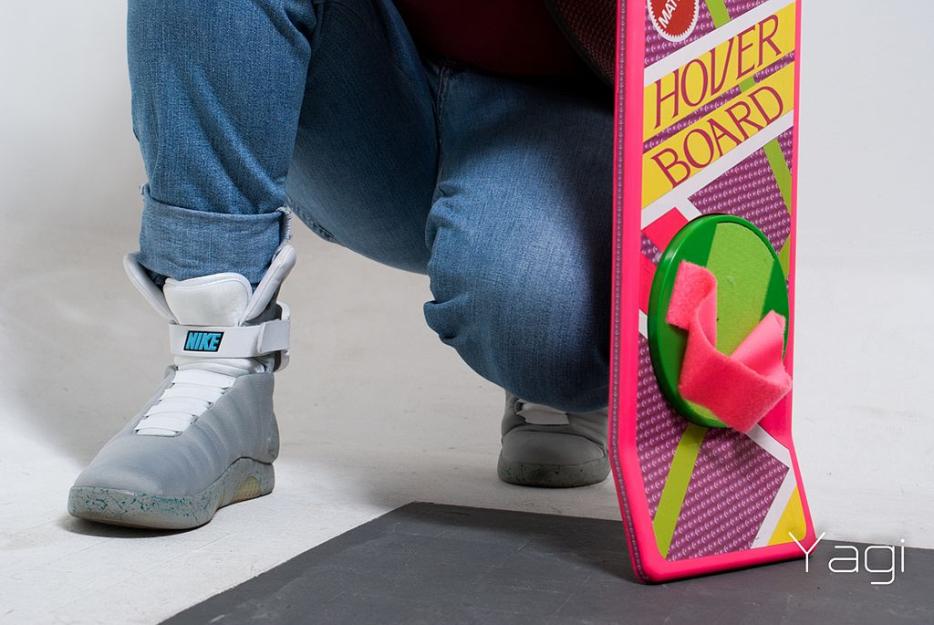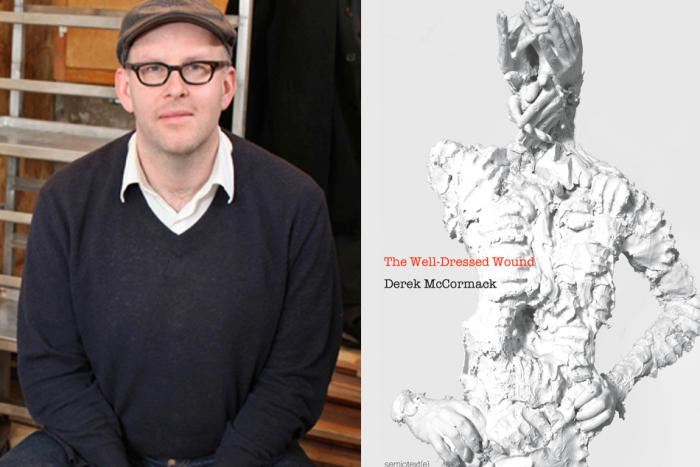As Marty McFly walked out of the alleyway and into the town square, he was distracted not by the flying cars whizzing by high above but by a robotic Texaco attendant. Then he was attacked by a holographic shark. Having just gone back in time to 1955 to ensure his parents fall in love, Marty had travelled forward to 2015 from his home in 1985 to protect the fate of his children.
I was born in the mid 1980s, and Robert Zemeckis and Bob Gale’s portrayal of 2015 in 1989’s Back to the Future II was captivating for me. Hoverboards! Flying Cars! Dehydrated Pizza! As my horizons grew and my science fiction consumption became more and more wonky, I kept returning to the Back to the Future trilogy as something quite distinct: a positive near-future. It was notable among most ’80s science fiction in that its view of the coming decades wasn’t swimming in radioactive fallout. Even Star Trek’s socialist utopia of the 22nd through 24th Centuries was borne of a Eugenics War and a “Post-Atomic Horror.” There was something comfortable about a future swathed in Southern California pastels and consumer electronics.
This month, after enough Photoshop hoaxes to spawn a dedicated meta-serving Tumblr, history will catch up to, then surpass, the date Marty McFly travelled to in Back to the Future II (it’s Wednesday, October 21st, regardless of what you’ve heard). The majority of the conversation around this approaching date ranges from “where’s my hoverboard?” to “where are my power laces?” It’s an easy piece of content for everyone from Slate to CNET, to io9, and an even more obvious PR tactic for companies such as Nike, Pepsi, and Lexus, who released or teased limited edition iterations of various promised products in the lead-up to Marty’s ordained arrival in 2015. Some of us have even settled by calling self-balancing electric scooters hoverboards, despite the fact that they run on two wheels and definitively do not hover. This desperation speaks to not only the winking seriousness afforded the series, but to the power of the future presented, and the way in which it’s constrained our ability to imagine anything else.
*
The Simplon Tunnel connecting Italy to Switzerland runs beneath the Alps, covered by, at some points, 7,000 feet of rock. When it was completed in 1906, it was the longest tunnel in the world, a title it would hold for nearly 80 years. The feat of modern engineering was a point of pride for the northern industrialists of Milan, who now had access to Western Europe and could begin the expansion that would fuel the Italian economy for decades to come.
The tunnel and trains that travelled through it were a symbol of modernity, and their portrayal became an early example of a technological aesthetic used to articulate a political message. This aesthetic was explicit, for example, when Milan hosted their second International Industrial Exposition that same year. In postcards, medals, and literature advertising the event, the tunnel and train featured heavily. In one poster, it was depicted steaming towards shining Milan on the horizon, driven by Mercury himself, the Roman god of trade, travel, and communication. Milan, under the industrialists’ control, was where the future would be forged.
 Futures—the stuff of which science fiction is made—are a product of modernity. When we started seeing human history as a progression, the future became possible to conceive. Modernity is a technology that allowed this, just as Polo and Mandeville’s tales of “the Orient” were made possible by contemporary advances in naval architecture and cartography. Maybe demonstrating the inevitability of this progression, the term “science fiction” first appeared within two decades of the first use of the word “science,” in the 1830s.
Futures—the stuff of which science fiction is made—are a product of modernity. When we started seeing human history as a progression, the future became possible to conceive. Modernity is a technology that allowed this, just as Polo and Mandeville’s tales of “the Orient” were made possible by contemporary advances in naval architecture and cartography. Maybe demonstrating the inevitability of this progression, the term “science fiction” first appeared within two decades of the first use of the word “science,” in the 1830s.
Looking back, historical science fiction can tell us a great deal about the past. As an extrapolation of the observed progress of the time, as well as the values and biases that coloured those observations, it serves as a reflection or artefact of the period and culture that created it. Inversely, it’s a relatively new idea that there’s also a recursive relationship with the future as well, where, as in the case of Star Trek, conceptions of the future have guided modern research and the development of technology first proposed as futuristic. It might have been nothing more than a very expensive PR play, but would Lexus have invested in the research leading to the creation of their hoverboard had the technology not appeared in film 30 years ago? At its most powerful, a proposed future can constrain our ability to imagine anything else, ultimately becoming a self-fulfilling prophecy.
These recursions affect us when we imagine the potential outcomes of our current actions. If we can assume our progress and imagine the future, then we take on the responsibility of acknowledging our own agency in creating that future.
What’s interesting isn’t so much the dark future painted by Zemeckis and Gale, or even their own intent in advocating for or against it, but the fact that they made it look so pretty that we all missed the point.
Marty McFly was given a gift so many of us dream about; to look ahead. When he didn’t like what he saw had come of his own life, he took the chance to change his course and set out towards a happier end—or, as Doc put it, “Your future is whatever you make it. So make it a good one.”
Determinism, the philosophical position that every current event or condition is a direct and unavoidable result of the events and conditions that preceded it, sounds like a Modernist thought, but its origins can be found in Philosophical Taoism—that the path of least resistance is effortless, as well as Marcus Aurelius’ Stoicism (“The laws of collective expediency required this to happen”). In both the Tao and Stoicism, free will isn’t negated by determinism, which is a good thing when considering the complications removing personal agency would have on a movie about time travel.
Marty was given the same agency that fictional futures purport to give us, by allowing us to see the conclusion of our own path and correct course accordingly. They’re entirely speculative, but in attempting to create something believable, they claim their own accuracy, and place the same responsibility on our shoulders. Of course, anytime a thing proposes agency and responsibility, it becomes political. Futures, whether positive (“If you listen to me, this is how good things will be”) or negative (“If you don’t listen to me, this is how bad things will get”), are political communication. In the words of Mayor Goldie Wilson, “Progress is his middle name.”
*
An alternate history is not a future, but it is consistent with the overarching message of the Back to the Future trilogy that our future is governed by the decisions we make today, just as our today is the result of the decisions we’ve made in the past. In Zemeckis and Gale’s vision, progress is measured through material gain.
In We Don’t Need Roads: The Making of the Back to the Future Trilogy, Caseen Gaines describes a conflict with Crispin Glover, who played Marty’s father George McFly in the original film but didn’t appear in the sequel. Glover recounts his issues with the ending of the first film, and the materialist message the ending sent: As Marty returns to a revised present based on his own meddling with the past, the McFly house is noticeably better off, with designer furniture, a new truck in the garage and an older brother who’s traded his fast food uniform for a banker’s suit. According to Glover, his protestation over what he called “propaganda” was a main factor in the deterioration of his relationship with Zemeckis and Gale.
For the book, Gaines spoke to more than 50 people involved in the films’ production, including Joanna Johnston, the costume designer for the second instalment, who detailed the priority that Zemeckis and Gale placed on product placement when recounting her experiences working with Nike on the now overdue powerlaced sneakers.
Zemeckis and Gale's directive that the Hill Valley of the future is filled with brands recognizable to a 1989 audience has, in many ways, proven prescient. While the brands that surround us aren’t projections for small businesses like hover-conversion garages, the only Apple product seen in the film is in the window of an antiques shop, and the manner in which ads attack you today is more elegant than the fake shark, it’s all not far off. It’s also a reflection of the time when it was made; the heady days of “where’s the beef” and a movie star president; glasnost and a McDonald’s about to open in Moscow’s Pushkin Square; Max Headroom selling New Coke. Product placement was a relatively new revenue stream for financing a film, but as logos found themselves in our films and TV shows more and more, their continued inclusion recursively started to feel like an accurate portrayal of American life.
“We were promised jetpacks!” they whine. Yeah, dude, but what you got was Agent Orange.
As transnational corporations and the brands that comprised them took a greater role in people’s lives in the 1980s, Zemeckis and Gale's decision to include an accelerated form of it in their vision of the future sent its own implicit political message in the present; that the increasing importance those brands were playing would continue unabated. Of course, they did it with some tongue in their cheeks. The insinuation that the Jaws franchise would continue to a 19th installment directed by Stephen Spielberg’s son Max is an ironic commentary not on the future but on the Hollywood system of the 1980s that Spielberg helped create. Surely it was also an intended irony to have Marty McFly Junior turn on six channels at once, critiquing attention-lacking teenagers and the exponentially increasing offerings of cable television at the time.
What’s interesting isn’t so much the dark future painted by Zemeckis and Gale, or even their own intent in advocating for or against it, but the fact that they made it look so pretty that we all missed the point. In 1989, it was absurd to imagine that your boss would be able to monitor your communications at home. Now it’s a horrifying reality, and yet our largest lament is that we can’t buy a specific consumer electronic.
*
“Everyone is under the delusion that they’re special,” said Futurist Madeline Ashby in a panel on the future of the Internet, surveillance and privacy last year. People curate a well-edited version of themselves that they hope makes them appear unique, but the governments and corporations controlling that data couldn’t care less. As Ashby describes the increasingly penetrating surveillance apparatus, a link can be drawn to middle-aged Marty’s boss listening to his home communications, even as modern algorithms make manual observation unnecessary for Mr. Fujitsu. In an essay published earlier this year, Ashby responded to a frequent question posed to her: why so pessimistic? “When people ask me, ‘Why can’t you be more positive?’” she wrote, “what I hear is, ‘Why can’t you tell me a story that conforms to my narrative and comforts me?’” Ashby’s essay was written, partially, as a response to another optimistic future: Brad Bird’s Disney flop Tomorrowland, and a certain type of geek whom laments they were promised jetpacks, though it could just as easily have been about hoverboards.
"America’s problem is not that it needs more jetpacks. Jetpacks are not innovation. Jetpacks are a fetish object for retrofuturist otaku who jerked off to Judy Jetson, or maybe Jennifer Connelly’s character in The Rocketeer. 'We were promised jetpacks!' they whine. Yeah, dude, but what you got was Agent Orange. Imagine a Segway that could kill you and set your house on fire. That’s what a jetpack is."
Jetpacks are not futuristic to us anymore because they don’t take into account our current context; they’re reflective of another time, when the problems posed by mass jetpack adoption weren’t immediately apparent. To ignore that things have changed and that they will continue to change is obviously irresponsible for a Futurist, and Ashby criticises her contemporaries who seem satisfied to conceive of and articulate futures that are predicated on the world not changing. By positioning change as impossible, the status quo implicitly becomes natural—an alarmingly political act.
When Zemeckis and Gale filled their future with ads, they extrapolated where the world was as they saw it and built something that made sense, while also making natural the absurdity of the time.
Maybe in presenting the continued growth of a consumer culture as both comfortable and inevitable, they made it less likely any other idea would find a root. It’s a stretch, but it’s not a difficult case to make that if we’re only presented with one type of future, our ability to conceive an alternative is diminished. Remember, this was a time when, not just in our fictions, the options being afforded us were the triumph of capitalism over the evil communist empire or nuclear annihilation. Faced with those two visions, it’s exhausting, even now, to try to see an alternative.
*
Constraining visions of the future to naturalize power is an effective tool to solidify one’s rule, and it can take on ugly forms. Just three years after the opening of the Simplon Tunnel, Filippo Marinetti published the Futurist Manifesto in the French newspaper La Figaro and created one of the first institutionalized uses of futures as a political tool. History isn’t kind to the Futurists, who are largely regarded as an inconsequential, immature movement, and while their engine-worshipping seems silly a century later, it annotates a ten-year period bridging the industrial promise of the dawn of the 20th Century and the rise of Mussolini's fascists with the help of those same Milanese industrialists.
Marinetti, a wealthy Milanese himself, built a movement that catered, either by coincidence or design, to the interests of the Industrialists. Rot and decay was to be excised, whether it manifest in the work of Impressionistic landscape painters or the liberal prime minister Giovani Giolitti, at that point in his third term of an eventual five. The machine was to be revered, whether that meant incorporating mechanical movement into art, or violently suppressing the Communist agitators who threatened to sabotage factories. Within just over a decade, Mussolini had marched on Rome, and while the Futurists held no special practical role in his rise, their output articulated the ideology of Italian Fascism through futures, allowing the Fascists’ message to be heard in the parlours as well as the streets.
Of course, futures can and have also been used to articulate dissenting politics as well. At the same time Mussolini was solidifying his control of Italy, the German director Fritz Lang was putting the final touches on one of the first applications of this new form of political communication in film. 1927’s Metropolis, which told the story of a futuristic city divided into two classes, the leisure-class who live in grand skyscrapers; and labourers who toil in vast subterranean factories and machine rooms, was overt in its vision of widening class-divides at the hands of an elite who control the means of production.
In the 1980s as well, there were futures articulating a variety of dissenting opinion, from laying explicit the horrors of nuclear war in films such as Threads and The Day After, to movements such as Cyberpunk, that extrapolated the same corporate and technological encroachments portrayed by Zemeckis and Gale in Back to the Future II, albeit in an entirely different, darker direction. While Back to the Future II’s 2015 promised an extension of the consumer comforts of the 1980s with robots running our stores, entertainment units inundating us with content, and incredible plastic surgery keeping us beautiful, Cyberpunk authors such as William Gibson were showing the alienation, displacement and violation those same technologies would bring us.
*
All this isn’t to say that the Back to the Future trilogy wholly lacked a conscience. Production Designer Larry Paull added a touch of realism to the first film which subtly critiqued the direction in which America was headed. In We Don’t Need Roads, Paull reminisces, “I wanted the present-day Hill Valley in Part I to be representative of the eighties, in how it was dressed. It was really run-down and funky. It was what happened to small towns ten, twenty, or even thirty years ago. The towns were dying and the stores were going out of business.”
We see this in the porn theatres and boarded up storefronts surrounding the town square, the drunk that Marty wakes up off the bench when he returns to his time, and maybe the roving (problematic) Libyans. Paull also served as production designer on Ridley Scott’s Blade Runner, a project that earned him an Oscar nomination, and probably put him at enough odds with Zemeckis and Gale’s pastel and coral future to explain his not being asked to return for the sequels.
Despite Paull’s absence, some pessimism runs under the surface of Part II. When Marty learns his future self lives in fancy Hilldale, he’s under the impression that he’s made a good life for himself. We quickly learn from the police, though, that it’s now turned to a dangerous neighbourhood. It’s not an admonishment of any trend in particular, but reflective of a time when Americans were increasingly anxious about crime. In Zemeckis and Gale’s future, it puts an asterisk on the amazing advances we see.
Perhaps the most pessimistic image in Part II was the alternate 1985 where Biff had taken over; Hilldale was a gaudy casino town that wouldn’t have looked out of place in Paull’s Blade Runner. Again, the films’ determinist message is clear: our world is the product of a progression of events that lead us to where we find ourselves, and beyond, while also allowing for the sort of free will that hinges that determinism on the character of the actors at play.
Biff’s motivations towards evil are never explored, although Part III implies that it’s hereditary. He’s simply the antagonist; a rapist, and in his hands, the future comes to reflect that. It is a stark contrast to the film’s otherwise materialist message that the manifestation of the success of evil would be so materialistic
*
As Robert Zemekis and Bob Gale’s portrayal of 2015 is overtaken by history this week, it, like all past futures, retains the majority of its value as an artefact of the realities and aspirations of the time that created it. Conversely, like all past artefacts, it shows us, to some degree, how we got to where we are today.
We might complain about how we don’t have hoverboards, or flying cars, or that we still need to bake our pizza like chumps, but Back to the Future II’s 2015 looks quite like our own, save for a few specific set-piece inventions. Targeted advertisements are real, though they reach us on a digital medium. Nostalgia is a marketable commodity, though today’s teens would be more likely to hang out at the Cafe 90s than the Cafe 80s. Even the wearable technology sported by Griff Tannen’s gang has been superseded—the ability to make a chicken noise may have seemed cool thirty years ago, but today it seems kind of hokey.
As political communication, it’s a lasting example of how futures can constrain progress to specific, designed ends. It’s unlikely that Zemeckis or Gale’s intent was to prop up capitalism with their film, and no one film could wield that power even if its producers wanted it to, but all futures are political. They offer a direction predicated on action today, by either offering a utopian carrot or a dystopian stick. They are the promise of consequence or reward, and if they’re powerful enough, they can suck up all the air in the room of our collective imagination and constrain our conceptions of what is possible.
The effectiveness of Back to the Future II—and the power of fictional futures—is apparent every time a nerd whines about having to tie their own shoes and travel on the ground. It constrained our ability to think of the future so tightly that these are the biggest injustices we can think of that the future-cum-present has tolled upon us.
Did the 2015 that Marty travelled to have drone strikes and government wiretapping? The pastel pink hoverboard did nothing to say that it didn’t, but there was an implicit promise in that scene that showed a positive future, even if there was a pessimism, ironic or not, under the surface. In that future we missed the point, and instead of getting mad about what we have, we’re now mad about what we don’t.
So on October 21st, instead of asking “where’s my hoverboard?,” ask yourself what else 2015 could have looked like.






